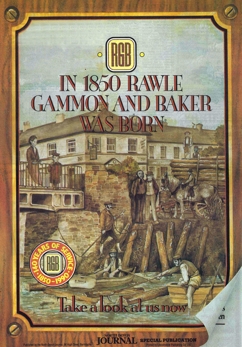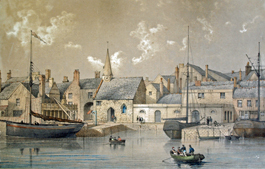Themes - StoriesStories about historical events in Pilton
Bringing together the strands of People, Buildings and Objects is the fourth of our five Themes - Stories about historical events in Pilton. The Pilton Story will bring together historians and writers to gather ideas for new 'Pilton Tales' from past and recent history to supplement the story of the Green Man and the Prior enacted annually at Pilton Festival.
These will be dramatised before local schools and other members of the community are approached to develop dramatic performances to explain other aspects of Pilton to Festival goers.

Through a mixture of drama, poetry, music and costume these tales will bring to life events, both real and mythical, from the 1000 year history of the village.
The Story of RGB in Pilton
 Rawle & Gammon was formed in Pilton in 1850 when Samuel Rawle, a shipbroker, joined forces with William Gammon, a builder, and set up as timber importers and saw millers on the banks of the River Yeo. In those days, timber was hand sawn from logs brought into the Taw/Torridge Estuary on large vessels, offloaded at Appledore onto barges or rafts and floated up the River Taw to Rolle Quay. This illustration of work at Rolle Quay is from a ND Journal Special Publication in 1990 celebrating 140 years. Much of the raw timber came from North America and in 1861 the partners acquired the steamship 'Ariadne', a three-masted barque, to take emigrants to Canada and bring back cargoes of timber. When the Barnstaple - Ilfracombe Railway opened in 1874, Rawle & Gammon were able to build a railway siding into Rolle Quay.
Rawle & Gammon was formed in Pilton in 1850 when Samuel Rawle, a shipbroker, joined forces with William Gammon, a builder, and set up as timber importers and saw millers on the banks of the River Yeo. In those days, timber was hand sawn from logs brought into the Taw/Torridge Estuary on large vessels, offloaded at Appledore onto barges or rafts and floated up the River Taw to Rolle Quay. This illustration of work at Rolle Quay is from a ND Journal Special Publication in 1990 celebrating 140 years. Much of the raw timber came from North America and in 1861 the partners acquired the steamship 'Ariadne', a three-masted barque, to take emigrants to Canada and bring back cargoes of timber. When the Barnstaple - Ilfracombe Railway opened in 1874, Rawle & Gammon were able to build a railway siding into Rolle Quay.The business became Rawle, Gammon & Baker when Samuel Rawle's son-in-law F A Baker became a partner. It prospered under the leadership of Baker and of Gammon's three sons with the impetus of the Second Industrial Revolution in the late 19th century and up to the start of the First World War. The business premises expanded on Rolle Quay and cottages were built for workers on Rolle Street. The late 1940s saw acquisition of Pilton Yard, the home of the Lynton & Barnstaple Railway which had closed in 1935. This was shared with the Sanders Sheepskin Factory. By the end of the 1940s the business was no longer just a saw mill but had effectively become the builders' merchants it is today.
It moved to the current site on the Pottington Industrial Estate in 2005 and the Rolle Quay site was subsequently developed by Redrow and McCarthy & Stone. The names of the development - Port Mill, Town Mill, Saw Mill and Orleigh Mill Courts - reflect something of the long history of the site as the home of RGB for 155 years. A fuller version of this story can be found on The Pilton Story Archive.
The Bells of St Mary's
 The tower of Pilton Church was rebuilt as it is today in 1696 after the spire and probably the bells were melted down for cannon or shot during the English Civil War (1642-46). Three of the six bells present in 1712 are still rung today. However, in 1853 the other three were taken to Loughborough by sea to be re-cast by John Taylor & Sons and two new ones were made, all at the personal expense of Robert Chichester.
The tower of Pilton Church was rebuilt as it is today in 1696 after the spire and probably the bells were melted down for cannon or shot during the English Civil War (1642-46). Three of the six bells present in 1712 are still rung today. However, in 1853 the other three were taken to Loughborough by sea to be re-cast by John Taylor & Sons and two new ones were made, all at the personal expense of Robert Chichester.In 1854, they were brought back to Pilton via Bristol on the sailing smack ‘John & Ann’ (seen far left in a lithograph of 1852 reproduced by kind permission of The North Devon Athenaeum). This was still the most common form of transport to North Devon in 1854. The new bells, weighing over 2 tons (2000kg) altogether, were hauled up Pilton Street on sledges and lifted into place in the belfry. The cost of the hanging, presumably raised by the Parish, was £158, equivalent to about £40,000 at today’s prices. It is reported that this scene was re-enacted at one of the Pilton Festivals. If you know any more, please let us know. Read more about the bells in THE BELLS OF ST MARY'S.
Go to the Submit Form to get in touch with us about Pilton tales of interest and getting involved with this part of the project.
